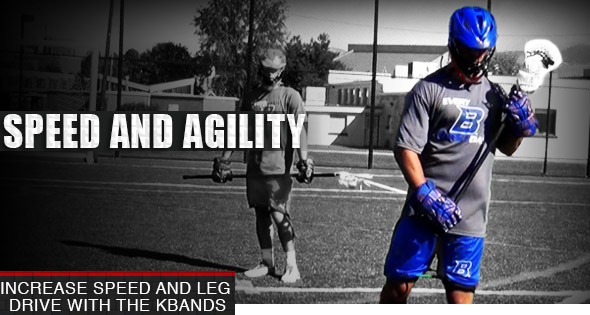Lacrosse Cradling Youth Lacrosse Drills
As youth players step onto the lacrosse field for the first time, they’ll be launching into a rewarding relationship with a sport that teach them about the basics of teamwork, effort, and growth—a relationship that might last for the rest of their lives. But lacrosse isn’t quite like any other team sport. Along with basic strategy, passing and receiving, and the coordinated offensive and defensive maneuvers that are integral to other sports, lacrosse also involves a unique device—the stick—and a special form of hand-eye coordination that players need to grasp before they can even participate in their first game.
Handling a lacrosse stick comes naturally for some and requires a bit of preliminary training for others. The best way to get a feel for the basics of passing and capturing the ball will come from hours of practice, and youth players may want to enlist the help of a friend or partner so they can practice on their own time, away from the field.
Meanwhile, youth lacrosse drills and lacrosse cradling drills like the one described in this video can help athletes develop the fine motor skills and coordination in the hands and arms that will lead to better control over the stick and eventually better control over the direction of the game.
How the Cradling Motion Works
The cradling motion begins with a loose, agile hand placed just under the net. Control of the net should begin in the fingertips and the pads of the hands. But the wrist, elbow and bicep are also essential to the direction and speed of both the throwing motion and the catch.
To handle the lacrosse stick perfectly, players should practice countless throws and catches to develop hand-eye coordination, but they should also concentrate on keeping the muscles of the bicep and shoulder strong. And complete warm-up drills like the one in this video can also develop the muscles of the hand, wrist and fingers, most of which are located in the lower arm between the elbow and wrist.
Executing the Lacrosse Cradling Drill
To complete the simple warm up demonstrated below, players can start by grasping the stick properly. First, the stick should stay out of the base of the hand. A lacrosse grip is not a simple clutching motion in which the hand holds the stick like a baseball bat. Instead, the stick should rest high and light against the pad of the hand where it will be most responsive to the motion of the fingers and wrist.
Lacrosse Cradling Drill: The Horizontal Orientation
Once the grip is established, the lacrosse player can hold the primary hand (the one closest to the net) in an upward orientation with the elbow at a right angle, as if executing a bicep curl. The other hand can lightly grasp the opposite end of the stick for control and balance. With the arms in this position, the athlete can raise and lower the head of the stick toward the chest and back to a right angle again several times in rapid succession. While executing this move, the player can rotate the stick with the primary hand, keeping the grip light and agile. This move can be executed for eight to ten seconds with the right hand in the primary position and then eight to ten more seconds on the left side.
Lacrosse Cradling Drill: The Vertical Orientation
After completing eight to ten seconds on each side with the horizontal grip, players can convert to the vertical grip. The stick can be held in the right hand in a vertical position with the palm facing forward. Again, the hand should grasp the stick lightly, and the pressure of the grasp should be higher and closer to the fingers than the wrist. The elbow should be held at a right angle and the bicep and shoulder should be active and engaged in the motion. Once the grip is correct, players can rotate the stick quickly, aiming the net to the back and front for eight to ten seconds at a time. Then the athlete can switch hands and perform the same motion on the other side of the body.
Dynamic Full Body Warm Up
After the arms, wrists, and hands have been engaged and the upper body warm up session is complete, lacrosse players can warm up and energize the legs and lower body using the added resistance of the Kbands leg resistance bands. The straps can be attached to the upper legs and the resistance bands can be clipped to the straps before players engage in a series of high knee runs, lateral drills, and cardio-focused warm up exercises. The details of the resisted dynamic lacrosse warm up can be found in the lacrosse training section of KbandsTraining.com, so lacrosse players and coaches can head to the site and review the demonstration video for more information.
Lacrosse Training With Kbands
In the meantime, KbandsTraining.com offers a growing list of lacrosse exercises, drills, technique tutorials and training routines that can help coaches get their teams ready for a demanding season. In the game of lacrosse, success depends on teamwork, agility, and control over the field, and all of these elements begin with targeted practice sessions that players can complete as a team or with a single partner. Offensive and defensive maneuvers, passing, scoring, blocking and deception are critical to complete lacrosse training, and the lacrosse section of Kbands Training.com offers videos that focus on all of these elements and more.
For more information about lacrosse training, and more video training resources for basketball, baseball, football, soccer and track, visit KbandsTraining.com. The site provides a growing collection of videos created and delivered by professional trainers and athletes for each respective sport. The site also offers purchasing and shipping details for training cones, resistance bands, and other training equipment, though most of these drills can be completed with just a net, a field, and standard protective gear.

